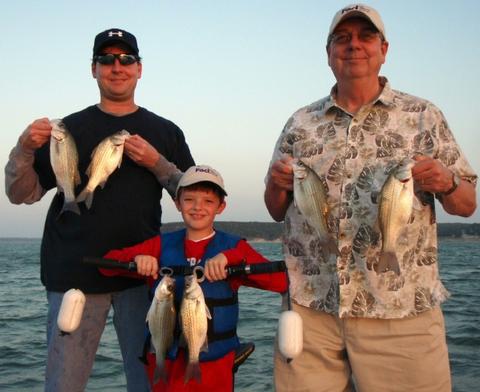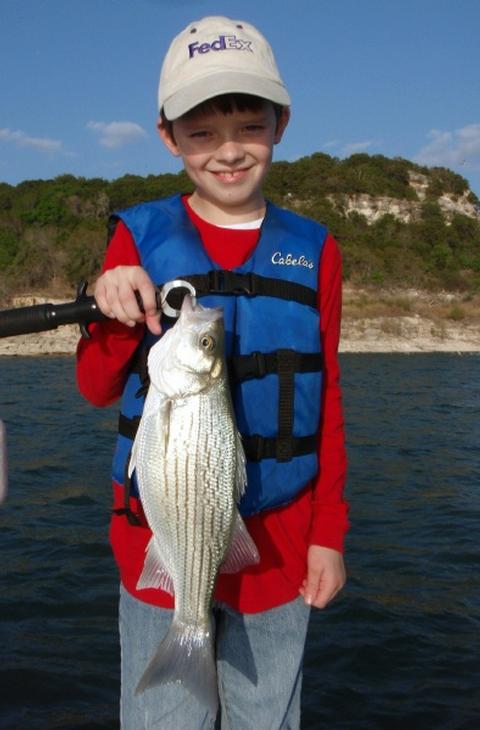We had a great family outing on Belton Lake this evening with a clan from Arlington, TX.

Tim (L), Mason (C), and Andy (R) … three generations aboard for some frenzied temperate bass action tonight!!

Mason, age 9, with his biggest fish of the evening.
Tim M. contacted me about the possibility of booking a trip after he’d decided to travel to Temple to visit a family friend in the hospital at Scott & White. When I was able to accomodate him, he worked his son, Mason, his dad, Andy, and his mom, Nancy into the plan and so at launch time it was we five versus the fish population of Lake Belton. Actually, the fishes’ odds were a bit better, as Mrs. Nancy was not a license holder and chose to just be a spectator and chief commentator.
I wasn’t really sure what to expect today as we had a mild front push through in the morning hours, turning the skies grey and humid and the winds very light and easterly (bad fishing!). This afternoon’s weather was definitely an improvement with winds up to 14mph, and from the SE. It’s that easterly component that is always a wild card. Too far east and the fishing tanks; a few degrees further south and, especially following poor conditions as we had this morning, the fishing can take off. Well, we got the latter and had a blast.
We began our trip around 4:30p and, under bright skies and SE winds found ample suspended white bass and short hybrids holding in a band from 13-17 feet deep over ~40 feet of water between Areas 574 and 753. We geared up with twin downriggers and at first had a ThinFin and a Pet Spoon in the spread. The fish showed a definite preference for the metallic Pet over the opaque Thin Fin, and once this trend emerged, we switched over to an all-Pet spread. From 4:30 until just shy of 6pm, we boated a mixed bag of 24 white bass and hybrid stripers with Mason and Andy doing most of the rod-work and Tim and Nancy cheering them on.
At around 6p, we began to see some bird activity — birds were just coming off the surface from a resting posture to a flying/searching mode. I should note here that the bird population is dropping off steadily, as it normally does with the progression of the Spring season. Anyway, we kept our eyes peeled and, in less than 15 minutes or so, began to see some coalescing of bird action right on top of Area 755.
We packed up the downrigging routine, got carefully on top of these fish by motoring near them, then closing the final 40 yards or so with the trolling motor. Once I found the center of mass of the feeding fish, we hovered in place and I gave some quick reminders about our technique (which we’d covered earlier so we’d be prepared). Mason, Tim, and Andy all did well right from the start using the smoking retrieve that I’d instructed them on. We very quickly boated 20, then 30, then 40, and eventually, a total of 85 fish from this area as the boys kept their technique consistent, their fish out of one anothers’ way, and their lines out of the trolling motor’s path.
As all three settled in to the technique, Tim observantly noted that Mason, the least experienced, was having the best results, despite the fact that all 3 fellows were fishing with identical gear and lures and were literally side-by-side. I explained that I often see this and have analyzed it. My conclusion is that, due to a lack of experience, kids tend to follow the pointers on the techniques I provide much more closely, AND have no pre-existing habits to overcome. Those more experienced, on the other hand, must often surpress or overcome natural tendencies in order to follow the techniques we use to a “T”. This evening, I pointed out to Tim he missed proportionally more of the fish he initially hooked because he was very fast and reflexive on his hookset. I noted that Andy lacked just a bit of smoothness and speed in his retrieve, thus making his lure a bit less easily overtaken by the gamefish beneath us. This resulted in a few less fish, and fish that were more deeply hooked than the lip-hooked fish that Tim and Mason were boating. These were in no way grievous errors, they were just slight variations from person to person that made a difference in how the fish responded. Mason had no “pre-existing conditions” and never set the hook, nor did he have any problem imitating the cadence of the retrieve speed I asked him to use once I showed it to him and reminded him from time to time. All three did very, very well, but the point is that minor variations in technique DO matter. These techniques get refined and revised as light, weather, and water temperature change and it is important if you desire to maximize your catch to recognize and respond to these variables.
Tim, a very good-natured fellow, took all of this in stride, “confessing” that he also had nagging habits in golf, and a tendency to dip his shoulder when at bat playing softball. He jokingly asked if there was any way I could fasten a knife or other pain-producing device to him to provide negative reinforcement each time he set the hook too quickly! For purposes of staying on the good side of my insurance carriers I will not disclose how that conversation ended!!
By around 7:30, the birds decided to call it a night early and headed to roost. The wind speed was picking up as well, and I knew anything else we may find in the way of fish would be anticlimactic compared to the feeding spree we’d just experienced.
We took advantage of the not-quite-setting sun to take photos with the natural light that remained and then headed back in with exactly 109 fish boated for my guests from Arlington.
TALLY = 109 FISH, all caught and released
TODAY’S CONDITIONS:
Start Time: 4:20p
End Time: 7:45p
Air Temp: 83F at trip’s start.
Water Surface Temp: ~66.7F
Wind: Winds were stiff from the SE at ~13, increasing to SE16 by trip’s end.
Skies: Skies were fair with cloud cover increasing from 10 to 25% over the course of the trip.

